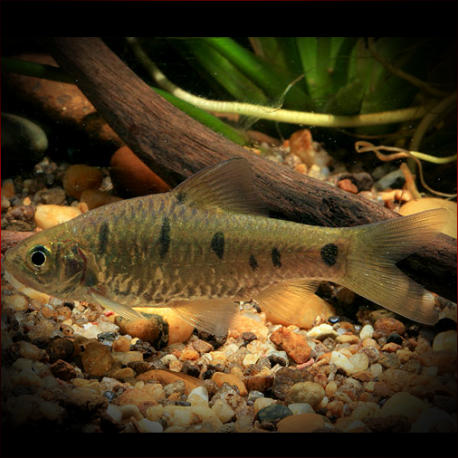상품설명
Datasheet
| 최소 탱크 크기 | 72 litres / 19.02 US gallons |
| 최대 크기 | 6.5cm / 2.56inches |
| 온도 | 18°C / 64.40°F - 26°C / 78.80°F |
| 경도 | 2.02dgH / 36ppm - 15.02dgH / 268ppm |
| pH | 6.0-7.5 |
General Description
B. aurotaeniatus, also known as Barbodes Aurotaeniatus, is a species uncommon in the aquarium trade. It has a single pair of maxillary barbels, a complete lateral line, and a distinct color pattern with small black markings on the flanks. The species was previously classified under the genus Puntius but was later transferred to the genus Barbodes due to nomenclatural updates.
Aquarium Setup
The species requires a tank size of a minimum of 72 liters and a setup that mimics a slowly flowing stream. To bring out its best colors, use subdued lighting, dark substrate, and decoration with plants, bogwood, roots, and floating vegetation. A mix of sand, gravel, or substrate with smooth rocks and aquatic plants is recommended. Provide gentle filtration, water movement, and some leaf litter for a natural habitat feel. Detailed water parameters include a hardness of 36-268ppm, pH between 6.0-7.5, and a temperature range of 18-26°C.
Behaviour
B. aurotaeniatus is known to be very peaceful and ideal for community aquariums. It thrives when kept in mixed-sex groups of at least 6-10 individuals, along with other schooling fish for added security. Males of the species display enhanced colors in the presence of rivals.
Feeding and Diet
Being foraging omnivores, these fish feed on worms, insects, small invertebrates, plant material, and organic detritus in their natural habitat. In captivity, they readily accept live and frozen foods like bloodworms, Daphnia, Artemia, alongside high-quality dried flakes and granules containing plant or algal content.
Reproduction & Dimorphism
While specific details of B. aurotaeniatus reproduction remain unknown, related species suggest they are egg-scattering free spawners without parental care. Adult males are typically smaller, slimmer, and more colorful than females, especially during the spawning period.
Habitat and Distribution
These fish are native to the lower Mekong River basin, inhabiting various biotopes such as streams, irrigation canals, and occasionally impoundments. Their distribution includes Laos, Vietnam, Cambodia, and Thailand, with sightings in minor coastal drainages in southeastern Thailand.

